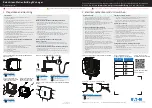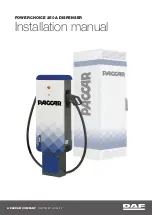
CV500 Valve
Instruction Manual
Form 5302
July 2006
12
Table 4. Assembly Clearance
PROCESS
TEMPERATURE
SEAT RING AND RETAINER CLEARANCE
mm
Inches
Minimum
Maximum
Minimum
Maximum
To 260
_
C
(500
_
F)
(1)
0.08
0.30
0.003
0.012
Over 260
_
C
(500
_
F)
(2)
0.20
0.43
0.008
0.017
1. Standard Trim
2. Special High Temperature Trim
1. Isolate the control valve from the line pressure,
release pressure from both sides of the valve body,
and drain the process media from both sides of the
valve. If using a power actuator, also shut-off all
pressure lines to the power actuator, release all
pressure from the actuator. Use lock-out procedures
to be sure that the above measures stay in effect
while you work on the equipment.
2. Remove line bolting. Then, remove the control
valve from the pipeline and place the valve on a flat
surface with the retainer (key 5) facing up.
3. Rotate the drive shaft (key 3) to move the ball
(key 2) into the open position.
Note
The retainer (key 5) was installed at
the factory using the torque listed in
figure 7.
CAUTION
After performing the following
procedures, place the retainer, the seat
ring, and both face seals on a
protected, flat surface where the
threads and inner surface will not be
contaminated or damaged.
4. Remove the retainer (key 5) by engaging the
retainer tool, attaching an impact wrench or other
suitable tool, and unscrewing the retainer. Inspect
the retainer. Place it on a protected, flat surface
where the threads and inner surface will not be
contaminated or damaged.
5. Remove the retainer gasket (key 11). Inspect the
gasket surface in the valve body.
6. Lift out the seat ring (key 4) and both face seals
(key 8). Inspect the parts and place them on a flat,
protected surface.
7. Inspect the shutoff surface of the V-notch ball. If it
is worn, nicked, or scratched, proceed to the
Replacing Ball, Shaft, and Bearings procedure in this
manual. If the parts are in good condition and do not
require replacement, continue to the Assembly
procedure in this manual.
Assembly
WARNING
Seat ring installation requires that the
ball (key 2) remain in the open
position.
The ball closes with a shearing,
cutting motion, which could result in
personal injury. To avoid personal
injury or damage to tools, valve parts,
or other items resulting from the ball
closing, prevent against ball travel by
using travel stops, manual actuators,
constant supply pressure to a
pneumatic actuator, or other steps as
appropriate. When installing the seat
ring, keep hands, tools, and other
objects out of the valve.
1. Apply enough supply pressure to the actuator to
open the ball, or take other steps to hold the ball
open.
2. Clean the valve body, the retainer threads, the
retainer gasket surface, and the seat ring sealing
surface.
3. Using either face seals (key 8) in good condition
or new face seals, place one seal in the seat ring
cavity of the valve body.
Note
The seat ring (key 4) may have one or
two shutoff surfaces. The shutoff
surfaces are the narrow, rounded
edges of the seat ring bore. Inspect
the seat ring and locate the shutoff
surfaces before proceeding.
Make sure the ball (key 2) is open while you install
the seat ring (key 4) and retainer ring (key 5). Before
installing the seat ring, open the ball or plug.
Insert a screwdriver, pry bar, or similar tool between
the lower ear of the ball and the valve body. Use the
pry to move the ball tightly against the thrust washer
and bearing stop (key 7) on the actuator side of the
valve. Keep the ball in that position until you finish
installing the seat ring.













































